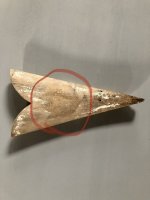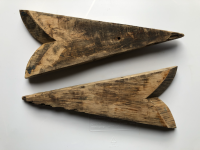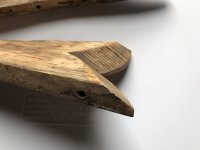Hoping some of the wood canoe experts on the forum can chime in about a new acquisition. I think it might be a possible pre-fire Chestnut built before the Dec 1921 fire destroyed the factory and all the building forms. Apologies for the quality of the photos which were taken during a freak snow squall right after I set it up outside...
![[IMG] [IMG]](https://blogger.googleusercontent.com/img/b/R29vZ2xl/AVvXsEhIkv8x33TI0lHUIoZbnAaSgs81L_aNqjH-8hrgECwW6vtu7mNiGt35jx7eNgaEqWnXaEHHt4unpOCoQyBAD56yVC_1k--jVtH63I5Ss6fAIwAXGJZUZOi62tqJqN4OXhd9eHfhDBZWZv3AfB41zGvb948EVHcMTahMwTmiEzpKFUbeI1OWEQj44W4eXg/w640-h480/t.jpg)
![[IMG] [IMG]](https://blogger.googleusercontent.com/img/b/R29vZ2xl/AVvXsEgv9u3Rbm2eLrntgQnCb21HNjCE8Qn8J-QwOkOAGU92_hwsu35pcGSHdY3-8pGOFt32fPCLkOgGAjmZMRQDsGBciV2W3RE5i9aFj_n_6GYrPzp3NiXsg3BK3pHUiO3OTDVsvOy0epyx42ben0LBENQHRudgP0kGBefnlTpBaVT-vzckES_nsbg03qj0jQ/w640-h480/IMG_20221218_093648.jpg)
![[IMG] [IMG]](https://blogger.googleusercontent.com/img/b/R29vZ2xl/AVvXsEhT1oBlzqe96_3M5GOQn4ZaB4b7GzI3J7pUauBWtrZg2-YDKivTX6vYl2tUXXD9_JGZ1vWke548Cs4frEd1Dw8iBDkOwY9P4PuAyImJiCmbyumtHY1mp_3zo2N_JFwJN9QfON9fZM4q69kPkJF5BPbUJkYdW5OTb_6AOeiQprS8Rtswlx7G1QHmlqpliQ/w480-h640/IMG_20221218_092010.jpg)
It looks to have seen some restoration during its lifetime so not everything is original, but here are the details that led me to this conclusion. Please feel free to chime in with your opinions & observations.
- dimensions perfectly fit with the pre-fire numbers of a Twozer (15' x 31" x 11-1/2") taken from this site here. The hull was measured using the earlier technique mentioned in the 1920 catalog after which Chestnut seem to have changed its measuring system...
- the post-fire numbers for the Twozer put the dimensions at 33" wide and this one doesn't reach that width no matter how it is measured.
- features closed gunnel construction with copper nails.
- ribs are 2-3/8" wide tapering to 1-3/8" where they disappear behind the inwale.
- the cant ribs are not the wider type seen in later model canoes but are similar width (untapered) as the ribs in the hull.
Evidence of previous restoration is as follows:
- the heart shaped decks don't look original to me but may be wrong. They are quite bright compared to the existing woodwork, lack major crowning and have minimal undercut. The Chestnut decal also looks slightly worn but the colors are still "fresh".
![[IMG] [IMG]](https://blogger.googleusercontent.com/img/b/R29vZ2xl/AVvXsEiDV_AGTUkYRL9YO4K9ATuwq8CM0pcMA29_OF_5FXeFMvCLX0Nga5XvspNvNMrJBc6wNp2YQMF8qNu4PAn5P36kovMnHybI4p0The0IUgU4Olg5-hz1_V3rHWcYLOilqeHig8-wUkpZxRrjP2FyQ1e0SsdG0zujKLVc3JgqjbymSi-bnnkhblCF-Vxesw/w480-h640/IMG_20221218_092336.jpg)
- center thwart is birdseye maple and nicely carved but not sure if this would have been the original style for this model.
![[IMG] [IMG]](https://blogger.googleusercontent.com/img/b/R29vZ2xl/AVvXsEg7beH3wrCZNMg5GTYgoVxiFypqlCZVS38zplEvT6Sfti4d0ak34vDEik7AQXtL7Qsb30pBQ6n7pz_NsX-5wz6WYEnZNE50DSLmo8vfcY2eMMa9bO1Y-hlz5W2R-pSi2EiG7_4OZqeGRNkHG9rBDV6LOAIRfU-J16vEyTNE6wb3NReMWrNncGtBgsfa-g/w480-h640/IMG_20221218_093733.jpg)
- The existing canvas has torn off the sheerline revealing newer looking planking secured with brass tacks rather than copper. Haven't fully removed the canvas yet to reveal any original planking.
![[IMG] [IMG]](https://blogger.googleusercontent.com/img/b/R29vZ2xl/AVvXsEhGtk1MjKVKDcFzJAsqBfelo5B0vyPtrziqqVN9k5YM_VssaYWr6dFJ7m6JOVjHuyrU_gmWTAPP4Qz0lJ16AoT6RrxsQ79ZZsWbYrPEUQ6S1d_FasZdD2c7PEoQJCxb9G6f_PdxDgTNmu28iTNFH7jJPi_l4qLplRRWO86KpWYdzIck29-Xt5fLaZj9rQ/w480-h640/IMG_20221218_092053.jpg)
- the 3/8" brass stem bands are secured with brass #4 Robertson square drive screws instead of slot screws.
Any other things I should be looking at to confirm pre- vs post- fire? It'll also be my first attempt at working with a closed gunnel system so any tips or suggestions would be most welcome.
![[IMG] [IMG]](https://blogger.googleusercontent.com/img/b/R29vZ2xl/AVvXsEhIkv8x33TI0lHUIoZbnAaSgs81L_aNqjH-8hrgECwW6vtu7mNiGt35jx7eNgaEqWnXaEHHt4unpOCoQyBAD56yVC_1k--jVtH63I5Ss6fAIwAXGJZUZOi62tqJqN4OXhd9eHfhDBZWZv3AfB41zGvb948EVHcMTahMwTmiEzpKFUbeI1OWEQj44W4eXg/w640-h480/t.jpg)
![[IMG] [IMG]](https://blogger.googleusercontent.com/img/b/R29vZ2xl/AVvXsEgv9u3Rbm2eLrntgQnCb21HNjCE8Qn8J-QwOkOAGU92_hwsu35pcGSHdY3-8pGOFt32fPCLkOgGAjmZMRQDsGBciV2W3RE5i9aFj_n_6GYrPzp3NiXsg3BK3pHUiO3OTDVsvOy0epyx42ben0LBENQHRudgP0kGBefnlTpBaVT-vzckES_nsbg03qj0jQ/w640-h480/IMG_20221218_093648.jpg)
![[IMG] [IMG]](https://blogger.googleusercontent.com/img/b/R29vZ2xl/AVvXsEhT1oBlzqe96_3M5GOQn4ZaB4b7GzI3J7pUauBWtrZg2-YDKivTX6vYl2tUXXD9_JGZ1vWke548Cs4frEd1Dw8iBDkOwY9P4PuAyImJiCmbyumtHY1mp_3zo2N_JFwJN9QfON9fZM4q69kPkJF5BPbUJkYdW5OTb_6AOeiQprS8Rtswlx7G1QHmlqpliQ/w480-h640/IMG_20221218_092010.jpg)
It looks to have seen some restoration during its lifetime so not everything is original, but here are the details that led me to this conclusion. Please feel free to chime in with your opinions & observations.
- dimensions perfectly fit with the pre-fire numbers of a Twozer (15' x 31" x 11-1/2") taken from this site here. The hull was measured using the earlier technique mentioned in the 1920 catalog after which Chestnut seem to have changed its measuring system...
"In the past we have measured our canoes for catalogue purposes as follows: - for width from inside to inside of ribs and for depth from top of rib to top of gunwales. We are now changing that method to agree with that in use elsewhere and in the future measurements will be for width, from outside to outside of canvas at widest point, and for depth from top of gunwales to outside of canvas."
- the post-fire numbers for the Twozer put the dimensions at 33" wide and this one doesn't reach that width no matter how it is measured.
- features closed gunnel construction with copper nails.
- ribs are 2-3/8" wide tapering to 1-3/8" where they disappear behind the inwale.
- the cant ribs are not the wider type seen in later model canoes but are similar width (untapered) as the ribs in the hull.
Evidence of previous restoration is as follows:
- the heart shaped decks don't look original to me but may be wrong. They are quite bright compared to the existing woodwork, lack major crowning and have minimal undercut. The Chestnut decal also looks slightly worn but the colors are still "fresh".
![[IMG] [IMG]](https://blogger.googleusercontent.com/img/b/R29vZ2xl/AVvXsEiDV_AGTUkYRL9YO4K9ATuwq8CM0pcMA29_OF_5FXeFMvCLX0Nga5XvspNvNMrJBc6wNp2YQMF8qNu4PAn5P36kovMnHybI4p0The0IUgU4Olg5-hz1_V3rHWcYLOilqeHig8-wUkpZxRrjP2FyQ1e0SsdG0zujKLVc3JgqjbymSi-bnnkhblCF-Vxesw/w480-h640/IMG_20221218_092336.jpg)
- center thwart is birdseye maple and nicely carved but not sure if this would have been the original style for this model.
![[IMG] [IMG]](https://blogger.googleusercontent.com/img/b/R29vZ2xl/AVvXsEg7beH3wrCZNMg5GTYgoVxiFypqlCZVS38zplEvT6Sfti4d0ak34vDEik7AQXtL7Qsb30pBQ6n7pz_NsX-5wz6WYEnZNE50DSLmo8vfcY2eMMa9bO1Y-hlz5W2R-pSi2EiG7_4OZqeGRNkHG9rBDV6LOAIRfU-J16vEyTNE6wb3NReMWrNncGtBgsfa-g/w480-h640/IMG_20221218_093733.jpg)
- The existing canvas has torn off the sheerline revealing newer looking planking secured with brass tacks rather than copper. Haven't fully removed the canvas yet to reveal any original planking.
![[IMG] [IMG]](https://blogger.googleusercontent.com/img/b/R29vZ2xl/AVvXsEhGtk1MjKVKDcFzJAsqBfelo5B0vyPtrziqqVN9k5YM_VssaYWr6dFJ7m6JOVjHuyrU_gmWTAPP4Qz0lJ16AoT6RrxsQ79ZZsWbYrPEUQ6S1d_FasZdD2c7PEoQJCxb9G6f_PdxDgTNmu28iTNFH7jJPi_l4qLplRRWO86KpWYdzIck29-Xt5fLaZj9rQ/w480-h640/IMG_20221218_092053.jpg)
- the 3/8" brass stem bands are secured with brass #4 Robertson square drive screws instead of slot screws.
Any other things I should be looking at to confirm pre- vs post- fire? It'll also be my first attempt at working with a closed gunnel system so any tips or suggestions would be most welcome.



